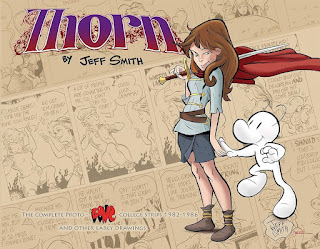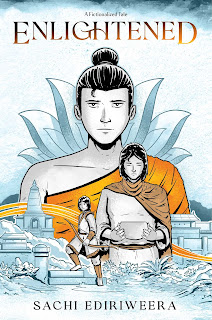Roaming by Jillian and Mariko Tamaki
The publisher says this is an adult book, but it’s about young people (nineteen; at my age nineteen is very young) figuring out what they want out of life and how to live in the world, so it’s at least thematically appropriate for not-quite-adult readers. I’m tagging it thus; complain in comments if you think high schoolers should be shielded from the view of first-year college students traveling to New York, drinking and smoking pot, swearing and causing trouble, staying in hostels and getting busy. (And then I’ll point and laugh at you, because you are just wrong.)
Roaming is the third major graphic novel by cousins Jillian Tamaki and Mariko Tamaki, after 2008’s Skim and 2014’s This One Summer . (So we can expect their next book together about 2035, assuming three points can be extrapolated infinitely.) I don’t know how they work together. Jillian is a cartoonist who does other projects all on her own, both writing and drawing. Mariko has written other comics, but I don’t think she draws. So my assumption is the art is all Jillian, but not that the writing is all Mariko. And we all know what they say about assumptions.
It’s set in 2009. Two friends who grew up together in some random Toronto suburb, Zoe and Dani, are meeting up at Newark Airport on spring break, to spend a week together in NYC, after going away to different Canadian colleges for the past year. Zoe is aiming for a STEM-ish degree; Dani is studying art – again, they’re second-semester freshmen, so all of this is new and somewhat tentative.
When they meet in Newark, Dani has brought along a new friend: Fiona, another art student, assured and opinionated and a former New Yorker herself. We think this will be the story of how Fiona’s presence affects Zoe and Dani’s old comfortable friendship, and that’s true…but not in the way we first expect, seeing quiet Zoe react warily to brash Fiona.
It’s organized into five sections, corresponding to the five days. We open with Zoe alone in that airport, and we close on a subway, all three women heading to one last new experience on the day they’ll fly out. And much-too-old me ended the book thinking they’re heading in the wrong direction, even if they do have most of the day, to be sure to get to the airport on time. But that’s old-person thinking; they’re trying to cram as much experience into a few days as possible – to be somewhere they’ve dreamed about for years. So I can worry about them, but I can’t fault them.
The plot is deceptively simple: they wander around the city, doing things – apparently from a list Zoe and Dani worked out ahead of time. Fiona, who was not part of the planning and is vastly less go-along and vastly more opinionated about everything NYC, pushes them in very different directions – not always the ones you’d expect. And Zoe connects with Fiona. And Dani and Zoe talk, eventually, about who they used to be as friends and who they are now after a year away at different universities.
My fingers wanted to type “universes” there. It’s almost equally true. They’re doing different things, living different lives, and we get only snippets of those new lives here – but enough to know they’re as tumultuous and often uncomfortable as most lives. They have idealized visions of each other – their dreams from high school, mostly – and Roaming is, in part, how they learn that they each are not the people they dreamed about being – maybe not yet, or maybe not ever.
What it’s mostly about is circling back to someone who was really important in your life, thinking you can pick right back up where you left off, and you both have changed. You may still be friends, you may still be really close friends, but you’re not sixteen anymore: you’ve both already changed, and you will both keep changing.
And the dialogue is great; true, in that broken, rambling, random way that people really talk. Half-thoughts, cut-off sentences, pasts alluded to rather than detailed. The Tamakis don’t tell us everything about Dani and Zoe, but they tell us what we need to know, and they show us how Dani and Zoe used to be with each other, and how they are now.
This is a lovely book about an important time of life, and an important kind of transition. We all have old friends, and we are all changing, all the time. Even if we’re no longer nineteen, Roaming has a lot to say to us.
Reposted from The Antick Musings of G.B.H. Hornswoggler, Gent.





















